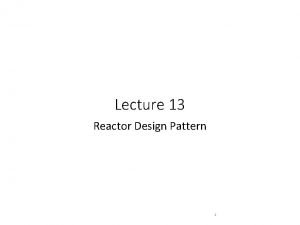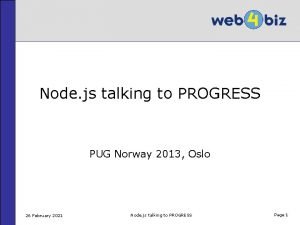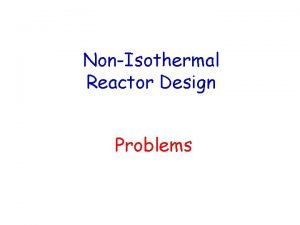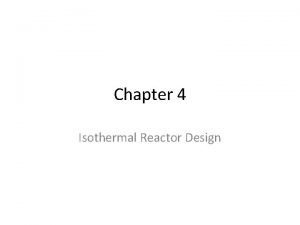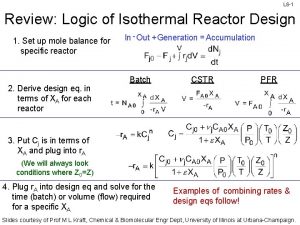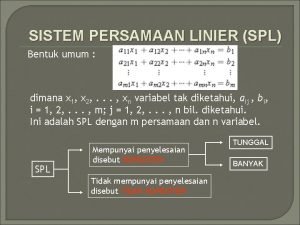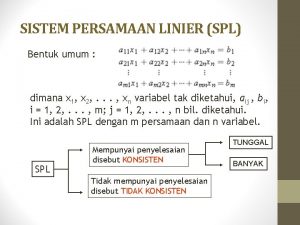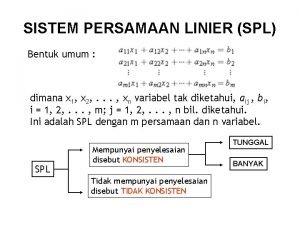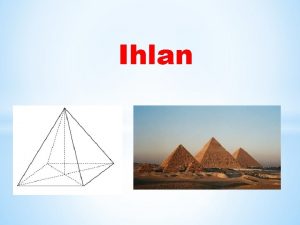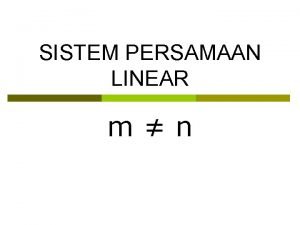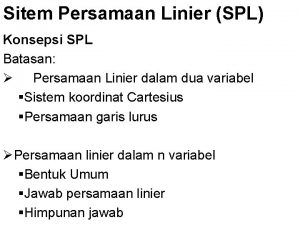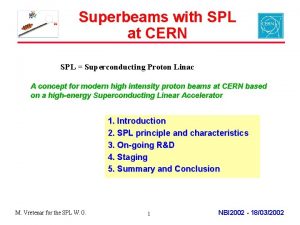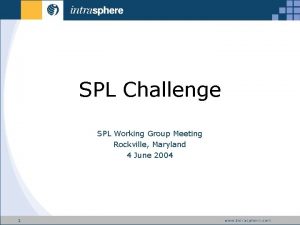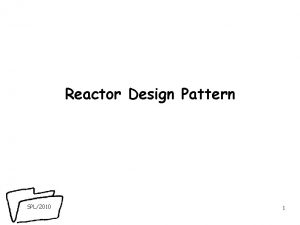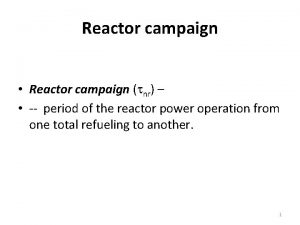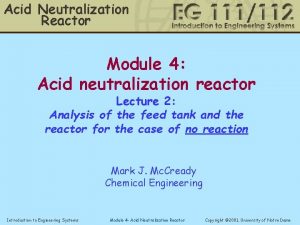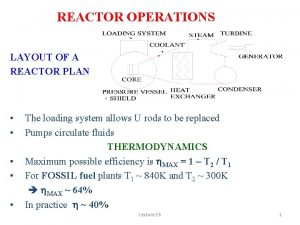SPL PS 11 The reactor design pattern Overview


























- Slides: 26

SPL – PS 11 The reactor design pattern

Overview • Why use the reactor pattern • Selector • The reactor

Why use the reactor design pattern • We saw in the previous PS the thread per-client server. • The main disadvantages of the TPC server are: • Wastefulness – Creating new threads is relatively expensive, each thread requires a fair amount of memory, threads are blocked most of the time waiting for IO. • Not scalable – A TPC server cannot grow to accommodate tens of thousands of requests. • Poor availability – Creating a new thread for each client takes a fair amount of time, the response time degrades as the number of clients increase.

What is the reactor design pattern • Use non-blocking IO, so threads don’t waste time waiting for IO. • Have one thread in charge of the network – accepting new connections and handling IO. • Have a fixed number of threads which are in charge of the protocol. These threads will be responsible for encoding and decoding messages, and processing them. • Unlike in the TPC server, each thread will handle multiple clients.

Selector • When we perform non-blocking IO, read for example reads the currently available bytes, and returns the number of bytes read. • That means that read/write can return 0, and probably would do that most of the time. • We would like to have a way for our thread to wait until any of our channels is ready, and only then perform the read(), write() or accept(), only on the ready channel.

Selector (cont) • The Selector registers itself to a channel. • Registration means that the channel informs the Selector when some event happens. • Such event can be – “The channel is ready to be read”, or “The channel can now be written to”, or “The channel can now accept” • During registration, the channel is told which events to monitor. • In addition when registering a Selector to a channel, one can add an attachment, which is an object we will have access to when the event occurs.

Selector registration • Registration can be done as follows: • The data structure the Selector maintains looks like this:

Bitmasks • We saw in the previous slide that the Selector maintains a field “Interested Ops” for every key. • Selection. Key. OP_READ is a number representing a read event. • Similarly, Selection. Key. OP_WRITE is a number represents a write event. • How would we represent a read or write event? • We could create Selection. Key. OP_READ_OR_WRITE, but this is cumbersome.

Bitmasks OP_READ - 1 0 0 0 0 1 OP_WRITE - 4 0 0 0 1 0 0 OP_ACCEPT - 16 0 0 0 1 0 0 OP_READ | OP_WRITE - 5 0 0 0 1

Bitmasks • We could use bitmasks, We’ll define values of the flags so their 1 -bits won’t overlap. • Read or write will be OP_READ | OP_WRITE. • When checking for read event, it’s enough to check e & OP_READ Different than 0 iff & 0 0 0 0 1

Selector’s select() • The Selector holds 3 lists of selection keys: • key – A set of all the selection keys in the Selector. • selected-key – A set of all the selection keys with a ready operation in the Selector. • cancelled-key – A set of all the selection keys that were cancelled but not yet unregistered in the selector. • Once a Selector is registered to some channel, one can use the “select()” method. • The method blocks until at least one of the channels is ready for the registered event. Then, a set of Selection. Keys is returned.

The Reactor • Now that we know how Java’s non-blocking IO works, we’ll take a closer look at the Reactor implementation which employs it. • We will concentrate on the “core” reactor classes – Reactor, Nonblocking. Connection. Handler, Actor. Thread. Pool. • The Reactor is the main thread, which is tasked with reading, writing, and accepting new connections. • The reactor also holds a thread pool of workers, these workers are in charge of message tokenization and protocol handling.

Actor. Thread. Pool • What would happen if a client sent two messages M 1 and M 2 to the server? • The server would create two runnables, R 1 and R 2 for tokenization and processing of these messages. • If these runnables would be executed in a regular thread pool, R 2 can be executed before R 1. • We want a special thread pool, which would make sure that the tasks for each client would be performed in the right order. • This is the Actor. Thread. Pool

Read Task Actor thread pool IO Thread

IO Thread Actor thread pool Protocol Enc. Dec Read Task

IO Thread Actor thread pool Protocol Enc. Dec Read Task

IO Thread Actor thread pool Protocol Write Queue Enc. Dec Read Task

IO Thread Actor thread pool Protocol Write Queue Enc. Dec Read Task

IO Thread Actor thread pool Protocol Write Queue Enc. Dec

IO Thread Actor thread pool Protocol Write Queue Enc. Dec

Actor thread pool Internal thread pool Actors (acts) Playing. Now

Actor thread pool Internal thread pool Actors (acts) Playing. Now

Actor thread pool Internal thread pool Actors (acts) Playing. Now

Actor thread pool Internal thread pool Actors (acts) Playing. Now

Actor thread pool Internal thread pool Actors (acts) Playing. Now

The Reactor (cont)
 Reactor design pattern
Reactor design pattern Reactor pattern
Reactor pattern Reactor pattern java
Reactor pattern java Reactor pattern
Reactor pattern Rbmk reactor design flaws
Rbmk reactor design flaws Non isothermal reactor design problems
Non isothermal reactor design problems Space time in reactor
Space time in reactor Reactor design project
Reactor design project Isothermal
Isothermal Damkohler number
Damkohler number Batch reactor design equation
Batch reactor design equation Urea reactor design
Urea reactor design Fukushima reactor design
Fukushima reactor design Ihlan spl
Ihlan spl Spl exceptions
Spl exceptions Contoh spl
Contoh spl Bentuk umum spl
Bentuk umum spl Bentuk umum spl
Bentuk umum spl Pengertian persamaan linear tiga variabel
Pengertian persamaan linear tiga variabel Spl hranol
Spl hranol Spl proyek adalah
Spl proyek adalah Povrch pláště jehlanu
Povrch pláště jehlanu Objem a povrch ihlana
Objem a povrch ihlana Spl energy
Spl energy Spl
Spl Dekomposisi lu adalah
Dekomposisi lu adalah Spl ihlana
Spl ihlana


